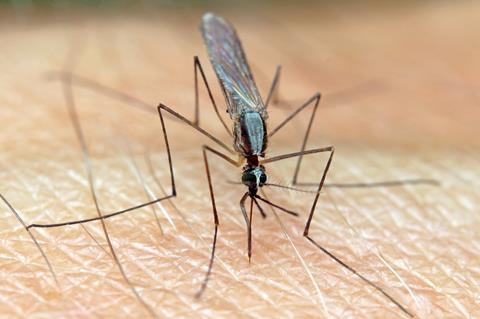A potent combination of antimalarial compounds added to bed nets blocked parasite transmission in mosquitoes while circumventing insecticide resistance, according to a new study led by researchers at Harvard T.H. Chan School of Public Health.

The finding dramatically expands understanding of druggable targets in mosquito-stage parasite development and lays the groundwork for a new, more effective way to prevent malaria transmission.
The study will be published May 21 in Nature.
“Malaria control desperately needs innovation,” said co-corresponding author Flaminia Catteruccia, Irene Heinz Given Professor of Immunology and Infectious Diseases and Howard Hughes Medical Institute Investigator. “This is a momentous step forward in the development of a new mosquito-targeted malaria control strategy, which could lead to a new generation of effective antimalarial bed nets.”
Global killer
Malaria is one of the leading infectious disease killers worldwide, leading to 263 million cases and 597,000 deaths in 2023. Although there was significant progress toward preventing the disease at the turn of the century, in the last decade cases and deaths have plateaued, due in part to widespread insecticide resistance in mosquitoes. Insecticide-treated bed nets, one of the most commonly used malaria control tools, have in turn become less effective.
READ MORE: Family of parasite proteins presents new potential malaria treatment target
READ MORE: Cutting off parasite’s energy supply could help fight malaria
The researchers performed a first-of-its-kind test of 81 antiparasitic compounds by applying them directly on Anopheles gambiae mosquitoes—key vectors for the disease—in order to identify which ones killed Plasmodium falciparum parasites, which cause over 90% of human malaria cases worldwide.
They found that 22 of the compounds significantly impaired P. falciparum development, and after further testing, identified two extremely active compounds that killed parasites through inhibiting different sites of the parasite mitochondrial electron transport chain, a target of antimalarial compounds.
Bed net prototypes
When the researchers incorporated these compounds in bed net-like prototypes, the compounds killed 100% of the parasites at very low concentrations. The compounds retained activity even after a year, and they efficiently killed parasites even when applied to the Anopheles female up to four days in advance of infection, significantly lowering the chance of the mosquito ever becoming infectious.
“This new malaria control strategy blocks mosquito-mediated parasite transmission without killing the mosquito and inducing resistance, which could extend the effective lifespan of bed nets,” said lead author Alexandra Probst, a doctoral student in the Biological Sciences and Public Health program.
“Importantly, our chemistry collaborators at Oregon Health and Science University were able to generate these compounds inexpensively, which would allow this approach to be integrated into existing bed net infrastructure at a competitive cost.”
Targeting the parasite
“Resistance to insecticides has compromised mosquito control efforts, particularly in Africa. One great advantage of this strategy is that it is focused on killing the parasite rather than the mosquito,” said co-corresponding author Dyann Wirth, Richard Pearson Strong Professor of Infectious Diseases.
Other Harvard Chan co-authors included Douglas Paton, Federico Appetecchia, Selina Bopp, Kelsey Adams, Tasneem Rinvee, Esrah Du, and Naresh Singh.
Support for the study was provided by the National Institutes of Health (NIH) grants R01AI148646 and R01AI153404, and by an Open Philanthropy and Good Venture Foundation grant GV673604528. Tres Cantos Open Lab Foundation, Medicine for Malaria Venture, and the Malaria Drug Accelerator provided several compounds tested in this study.







No comments yet